If strength training is the meat and potatoes of your exercise routine, mobility exercises are your “micronutrients”. The right mobility work can help preserve bodily function, stave off injury, and also improve your performance. (1) Don’t buy it? Here’s licensed Doctor of Physical Therapy Bo Babenko:
“In my line of work, I’ve seen so many injuries come down to the client not working through a full range of motion,” Babenko says, which means being flexible enough to access those ranges and strong enough to control them. That’s why you need mobility training — here are 12 of Dr. Bo’s favorite exercises for mobility.
12 Best Mobility Exercises, From a DPT
- Crocodile Breathing
- Single-Leg Supine Leg Raise
- Single-Arm Kettlebell March + Reverse Lunge
- 90/90 Hip Rotation
- Thoracic Foam Rolling
- Cossack Squat
- Shoulder CAR
- Sciatic Nerve Floss
- Dead Hang
- Banded Hip Mobilization
- Kang Squat
- Kettlebell Windmill
Recent Updates: BarBend Senior Writer Jake Dickson evaluated this article for quality and to ensure the expert-verified mobility exercises were presented in accordance with BarBend‘s evolving standard for movement prescriptions. Read more about that process here.
Editor’s Note: The content on BarBend is meant to be informative in nature, but it should not be taken as medical advice. When starting a new training regimen and/or diet, it is always a good idea to consult a trusted medical professional. We are not a medical resource. The opinions and articles on this site are not intended for use as diagnosis, prevention, and/or treatment of health problems. They are not substitutes for consulting a qualified medical professional.
What Is Mobility?
Mobility and flexibility are close cousins, but they aren’t the same thing. Mobility refers to your ability to move your body’s joints through a specific, desired range of motion.
Mobility benefits can also include pain relief, improved posture, stronger muscles and joints, as well as longevity. It is important to note that mobility and flexibility are not the same thing; but can work together to create overall improvements to someone’s training regime.
Mobility optimizes movement by actively increasing the range of motion within your joints and surrounding muscles. Flexibility and/or stretching lengthens your muscles passively through a range of motion.
- Nerve Flossing is a series of gentle exercises that can help to relieve pain and improve a person’s range of motion. These types of exercises involve applying tension to one of the nerves while releasing tension on the other. There is a “gliding” of the nerve back and forth that can help it to release, which can help the nerves to move more smoothly.
1. Crocodile Breathing
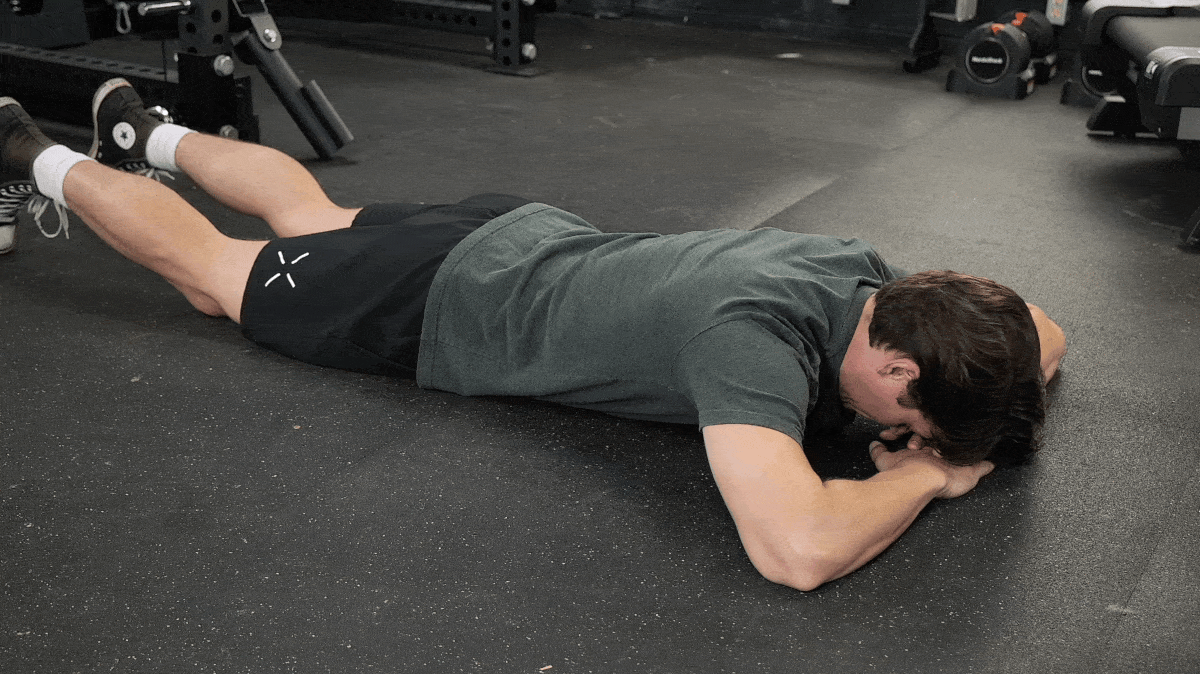
| Equipment Needed | Exercise mat (optional) |
| Muscles Worked | Diaphragm, abdominals |
| Sets & Reps | 3 minutes daily or before exercise |
“Deep belly breathing is the ultimate way to start any training session,” says Babenko. This rhythmic breathing technique will not only regulate your nervous system and prepare your mind for the workout to follow, but also serves as some introductory practice to proper abdominal bracing.
How To Do It
- Lie face-down on the floor and cross your arms in front of you, placing your forehead on the back of your palms.
- Exhale fully until you feel your torso empty of air.
- Inhale slowly and deeply, thinking about filling your body with air from your chest to your tailbone.
2. Single-Leg Supine Leg Raise
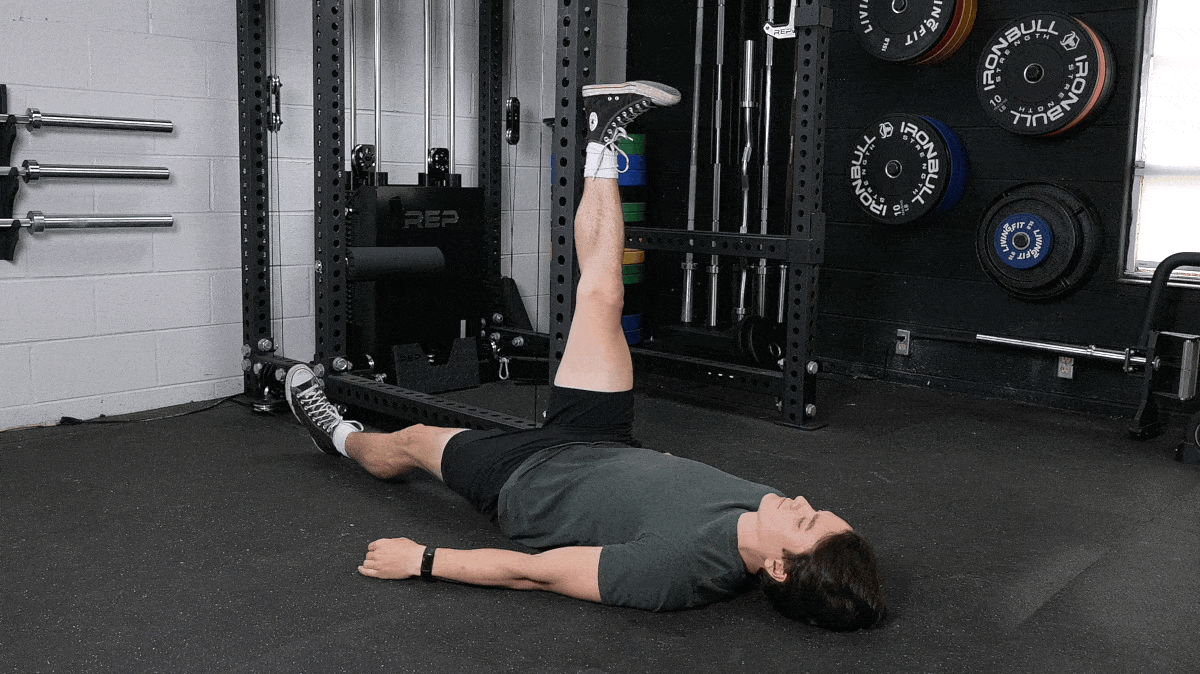
| Equipment Needed | Exercise mat (optional) |
| Muscles Worked | Hip flexors, abdominals |
| Sets & Reps | 2 x 10 |
According to Babenko, grounded core exercises like the leg raise are a phenomenal way of utilizing what’s called reciprocal inhibition — activating one muscle to signal an opposing muscle that it’s okay to relax. This move will train your core and may help improve hamstring flexibility.
How To Do It
- Lie on your back with one buttcheek scooted up against the pillar of a squat rack or door frame.
- Hike that leg up with your knee locked until you feel a stretch in your hamstring.
- Lift your shoulders off the floor slightly and compress your ribcage to activate your abs.
- With the other leg’s knee locked, gradually lift it until it aligns with your suspended leg and then slowly lower it back down.
3. Single-Arm Kettlebell March + Reverse Lunge
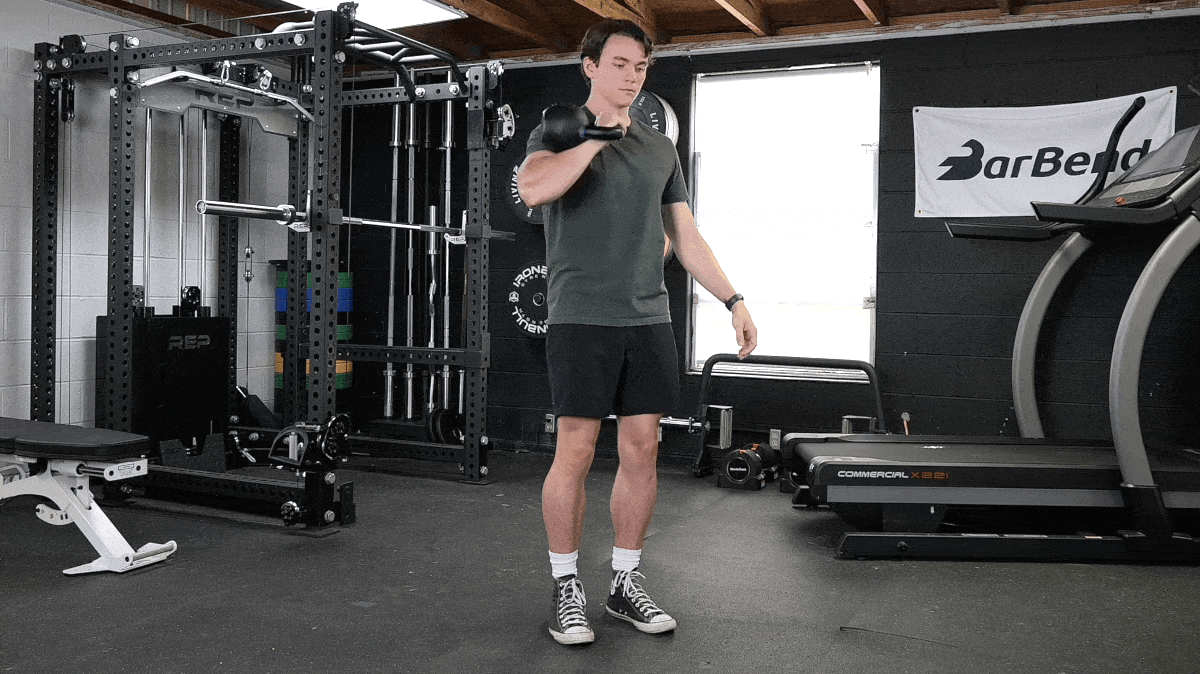
| Equipment Needed | Kettlebell |
| Muscles Worked | Obliques, hip flexors, abdominals |
| Sets & Reps | 3 x 10+ |
“This drill provides great ‘return-on-investment’ for the hips, and is one I personally do almost every morning,” Babenko says. The standing marches will actively engage your core and hip flexors, while the reverse lunges will then lengthen those tissues for a balanced stimulus.
Hip flexor training is often overlooked. This is one of the best mobility exercises for runners because it trains the muscles you use when you perform each stride on the track, court, or street.
How To Do It
- Rack a kettlebell on one side of your body in the front rack position.
- Brace your core and hold your non-working arm out to the side or at your hip for balance.
- Perform standing marches, bending your knee and lifting it up to waist height, alternating legs.
- Then, step backward into a reverse lunge position, alternating legs once again.
4. 90/90 Hip Rotation
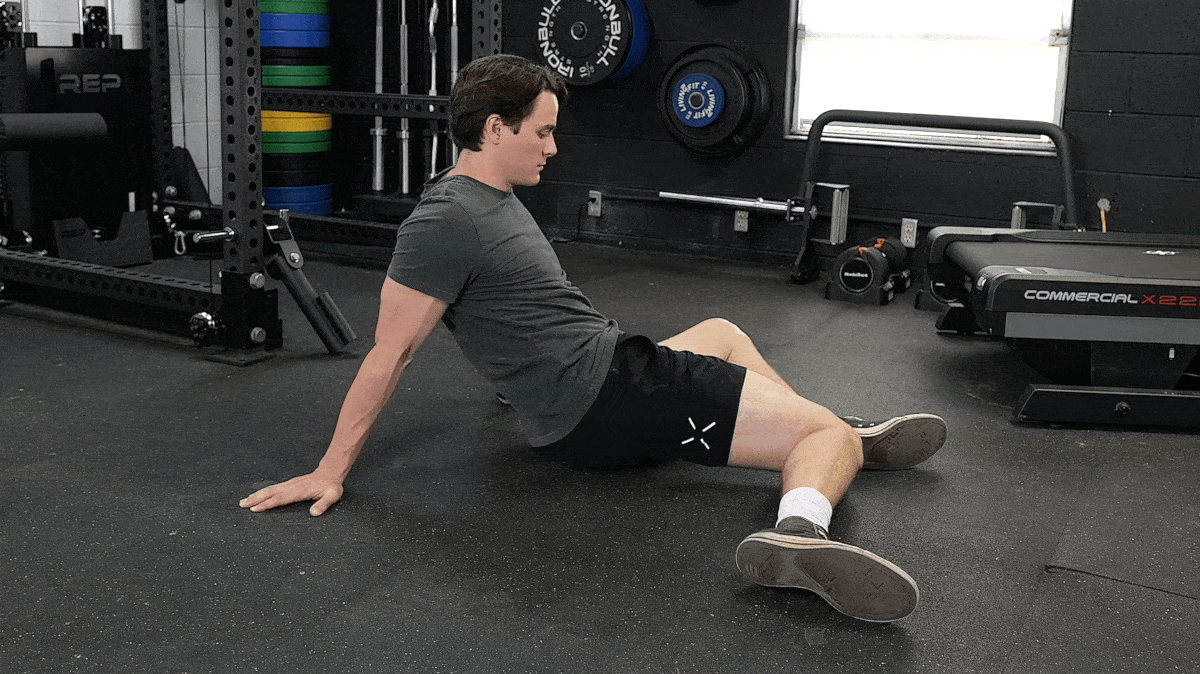
[Read More: How to Do the 90/90 Stretch to Squat Heavier and Move Better]
| Equipment Needed | Exercise mat (optional) |
| Muscles Worked | Hip flexors, hip adductors, glutes, abdominals |
| Sets & Reps | 2 x 8 |
For Babenko, “owning” a joint’s full range of motion is everything. You can use the 90/90 hip rotation to develop active control over both of your hip joints simultaneously. “The internal rotator muscles of the hip are hard to access and control for most,” Babenko says. The hip control required for this move makes it one of the best mobility exercises for athletes.
How To Do It
- Sit on the floor with your knees bent and tucked up to your chest.
- Sweep your right knee down and push your right foot out and around behind you, pulling that hip into internal rotation.
- Open the other leg and place the outside of that knee on the ground.
- Both of your legs should be on the floor, knees bent at 90 degrees each.
- Reverse the motion, switching hip positions slowly using your hip muscles.
5. Thoracic Foam Rolling
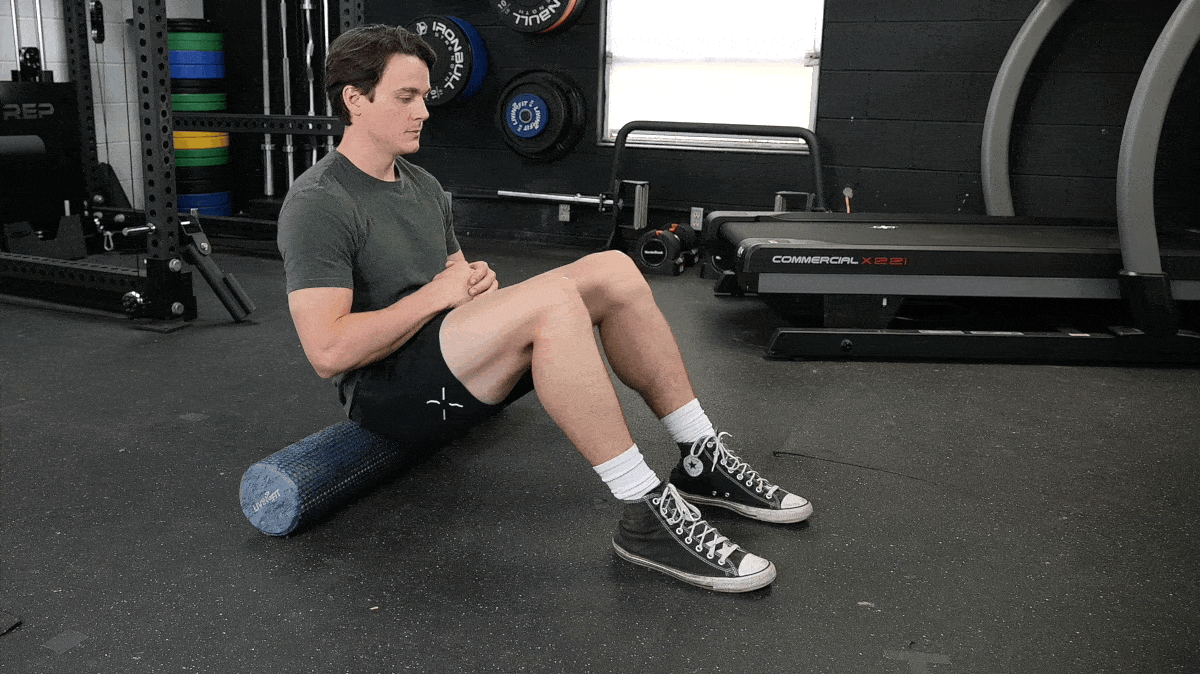
| Equipment Needed | Foam roller |
| Muscles Worked | Thoracic spine, upper back |
| Sets & Reps | 3 rounds of 30 seconds |
“Undoing the damage from the day”, as Babenko calls it, is one of the best ways to improve overall performance and ensure proper shoulder function. Thoracic foam rolling pulls your spine into extension, lengthening your abs, pecs, and anterior shoulder muscles in the process, which may grow tight after long periods of sitting or slouching. This is also one of the best mobility exercises for seniors who may struggle to mobilize their spines.
How To Do It
- Sit down with the foam roller up against your tailbone and your legs either straight out in front of you or bent at the knee.
- Slowly “slide” down into a supine position, until you’re either leaning fully against the roller or are arched over it with your upper back on the ground as well.
- Identify trigger points or painful areas in your mid or upper back and roll back and forth over them, breathing deeply.
6. Cossack Squat
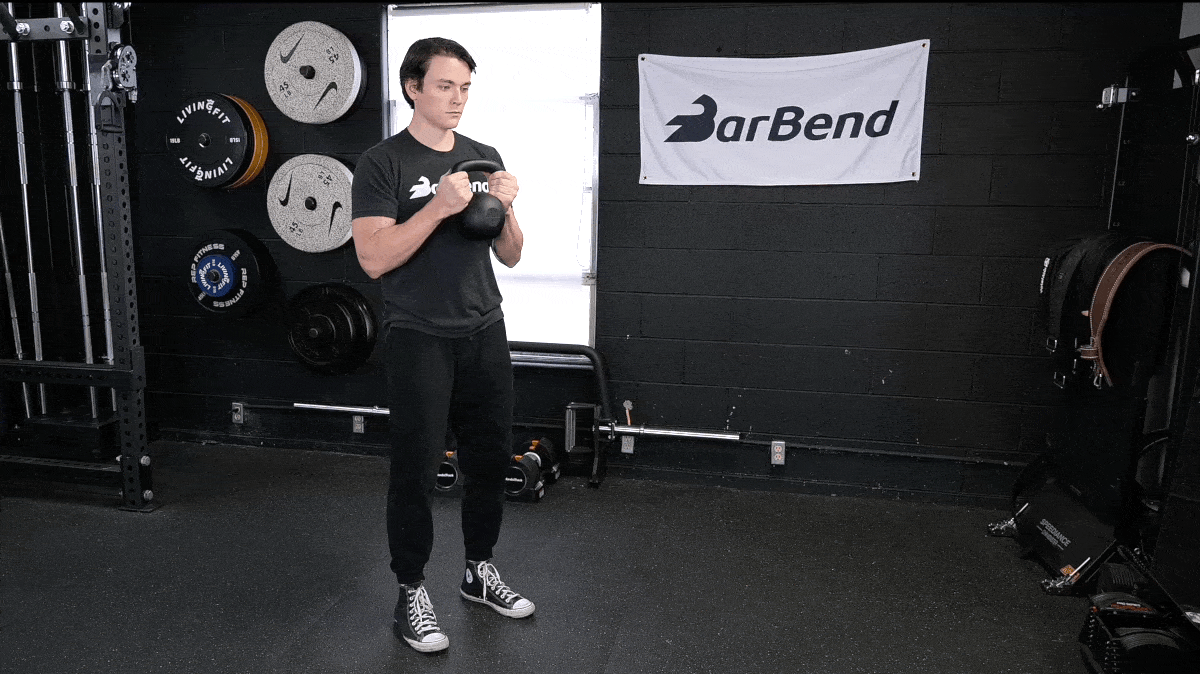
| Equipment Needed | Dumbbells (optional), kettlebells (optional) |
| Muscles Worked | Glutes, quads, core |
| Sets & Reps | 2 x 6 |
Think of Cossack squats as a single-leg mobility exercise that also enhances stability and control. This move is excellent for stretching out the insides of your thighs if you have trouble opening your hips. Also, the Cossack squat might just be the best ankle mobility exercise you’ve never done. Give it a shot:
How To Do It
- Stand in a wide sumo stance with your knees locked and your toes pointing slightly outward.
- Extend your arms in front of your body or cross them at your chest.
- Slowly push your hips back and sideways, sinking into a squat position on one side while using your other leg as a kickstand for balance.
- Reverse the motion, return to the starting position, and then squat deep into the opposing side.
7. Shoulder CAR
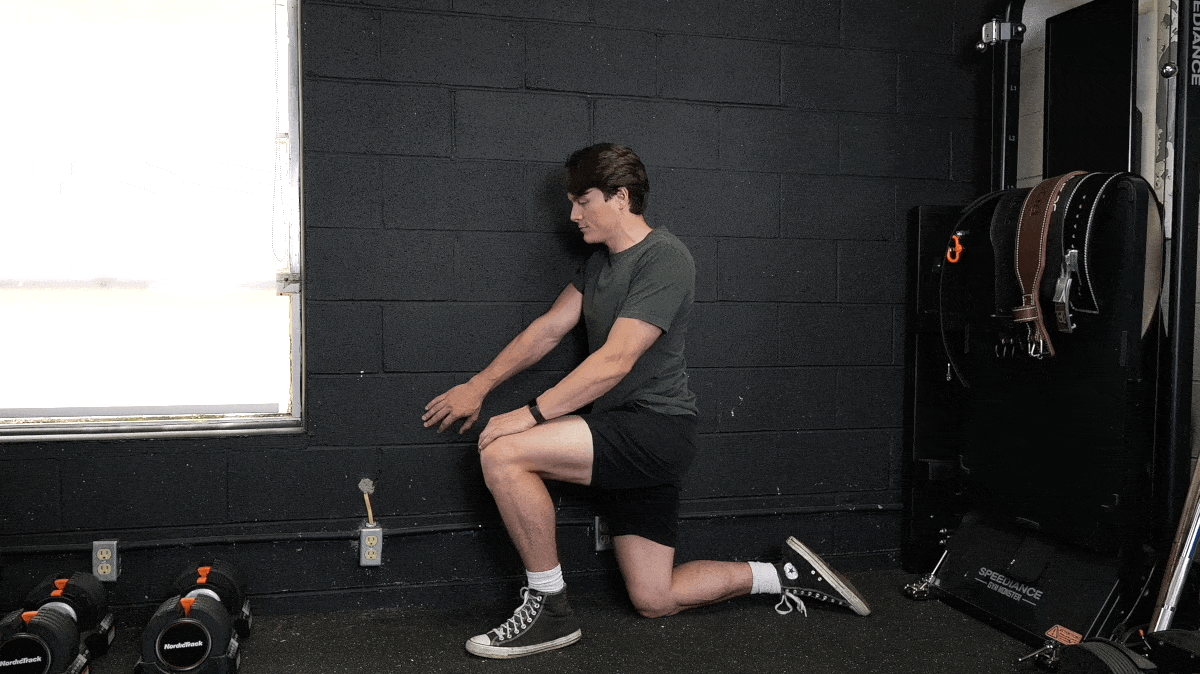
| Equipment Needed | Foam roller (optional) |
| Muscles Worked | deltoid, rotator cuff, upper back, pectorals |
| Sets & Reps | 2 x 5 |
In physiotherapy, “CAR” stands for “controlled articular rotation” — a fancy way of rotating a limb around a fixed point. The shoulder CAR takes your shoulder through its full range of motion and, according to Dr. Babenko, is one of the best ways to improve shoulder mobility.
How To Do It
- Take a half-kneeling position adjacent to a wall. The leg closest should the wall should be your “down” leg.
- For extra stability, place a foam roller between the inside of your “up” knee and the wall.
- Extend your wall-side arm out along the wall with your elbow straight.
- Slowly glide your arm up the wall in an arc motion, passing your head and extending behind your body.
8. Sciatic Nerve Floss
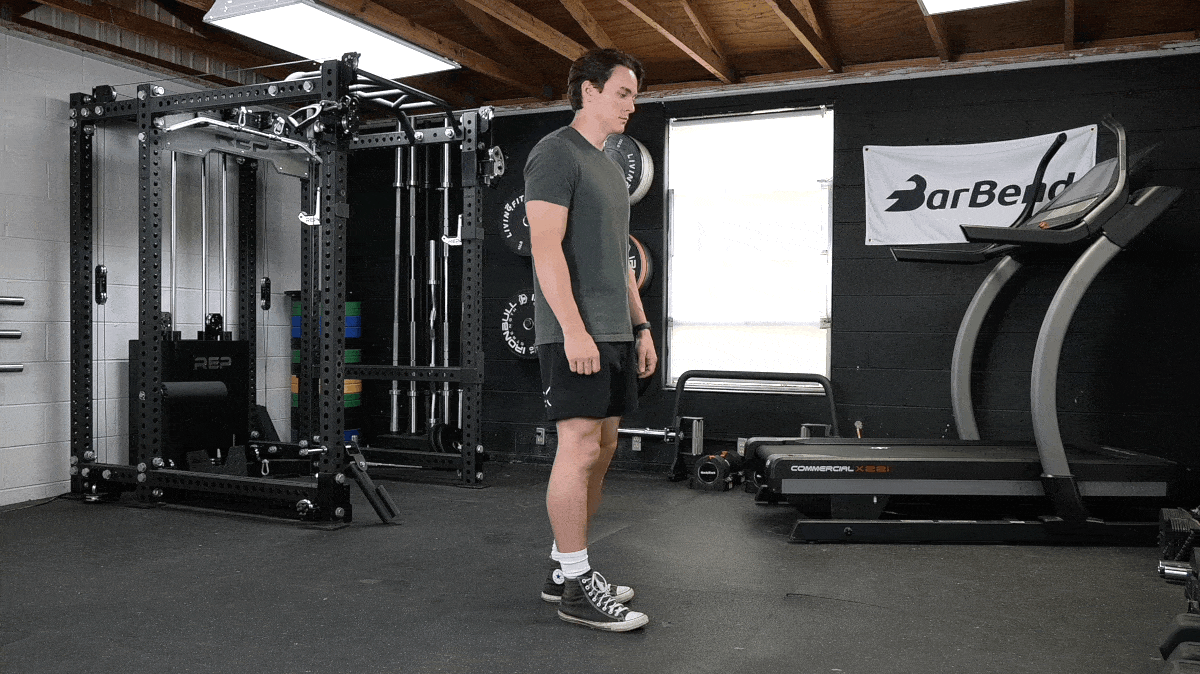
| Equipment Needed | Exercise mat (optional) |
| Muscles Worked | Hamstrings, lower back, hip flexors |
| Sets & Reps | 2 x 5 |
Babenko remarks that this one of the best mobility exercises for runners, skiers, or anyone who may mistakenly believe that they have tight hamstrings when the underlying cause may be neural in nature. Nerve “flossing” refers to performing a dynamic stretch that mobilizes neural tissue and treats associated symptoms. (2)
Editor’s Note: If you’re experiencing nerve-related pain or conditions like severe tingling or numbness, consult with a doctor right away.
How To Do It
- Stand upright with a staggered stance, placing one foot a few inches in front of the other, making contact with the ground with only your heel.
- Hinge forward, dropping your head towards your forward foot without bending your knees.
- As you drop down, actively sweep your arms forward as though you were scooping up the air.
9. Dead Hang
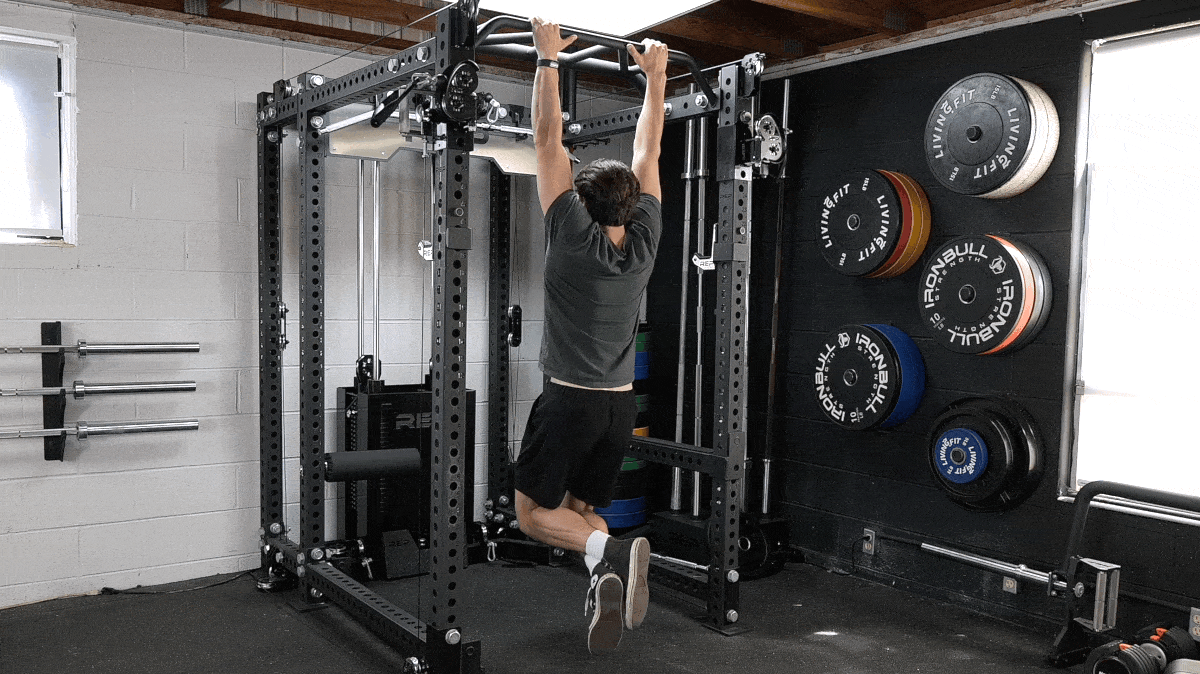
| Equipment Needed | Pull-up bar |
| Muscles Worked | Traps, anterior deltoids, pectorals, rotator cuff |
| Sets & Reps | 3 x 30 seconds |
“Accumulating time in a hanging position has all sorts of benefits,” Babenko says. Namely, dead hangs both improve shoulder mobility while also providing some axial decompression — they allow gravity to apply very mild traction to your spine, countering the compressive forces applied by moves like the squat or overhead press. Oh, and you’ll also get a free grip exercise along the way.
How To Do It
- Reach up and grab ahold of a stable horizontal bar with a shoulder-width, overhand grip.
- Slowly suspend yourself from the bar, hanging freely without swaying.
- Allow your shoulders to pull upward towards your ears as you hold your lower body motionless.
10. Banded Hip Mobilization
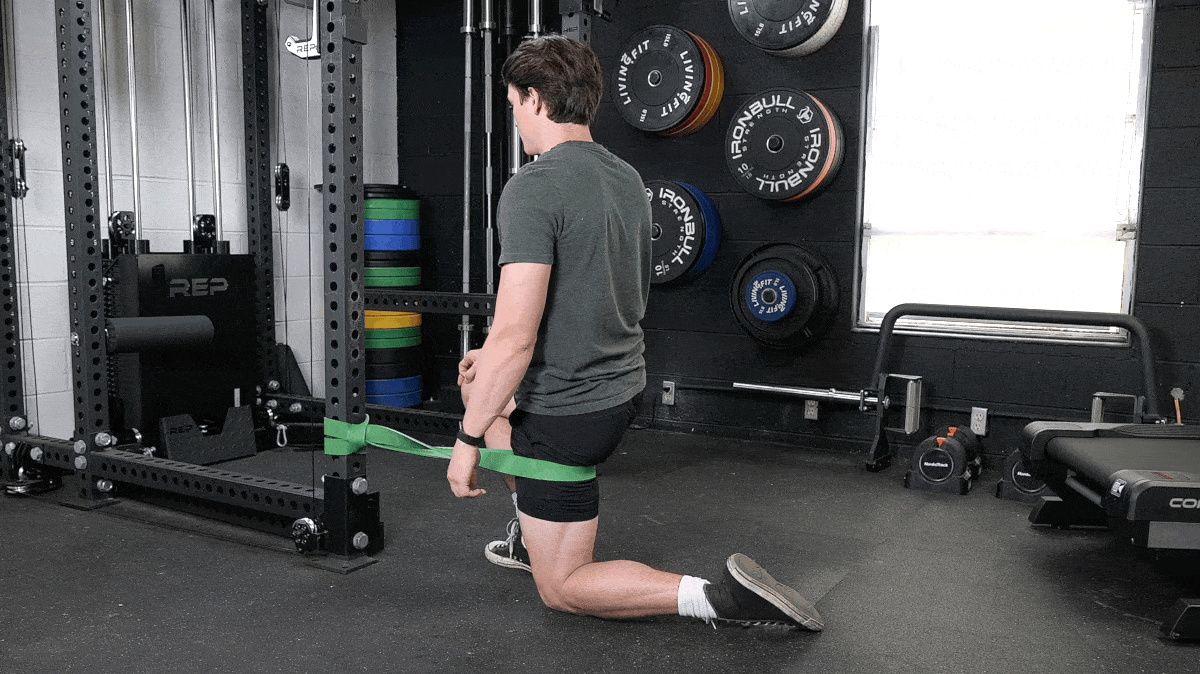
| Equipment Needed | Resistance band, squat or power rack |
| Muscles Worked | Glutes, hip flexors, core |
| Sets & Reps | 3 x 30 seconds per leg |
Babenko notes that one of the most common restrictions he sees in his practice is limited hip extension and internal rotation. “Using a heavy band to get the hip opened up with some overhead reaching incorporated is something I use with almost 90% of my clientele,” he says, as a way of stretching out a tight anterior chain.
How To Do It
- Tie a heavy resistance band around a stable structure like the frame of a squat rack at around knee height.
- Place one leg into the loop of the band, then hike it upward into your groin. The band should wrap around directly under your buttcheek.
- Take a knee, placing the banded knee on the floor and your opposite foot flat in front of you.
- Allow the band to pull your hip into extension until you feel a strong stretch along the front of your thigh.
11. Kang Squat
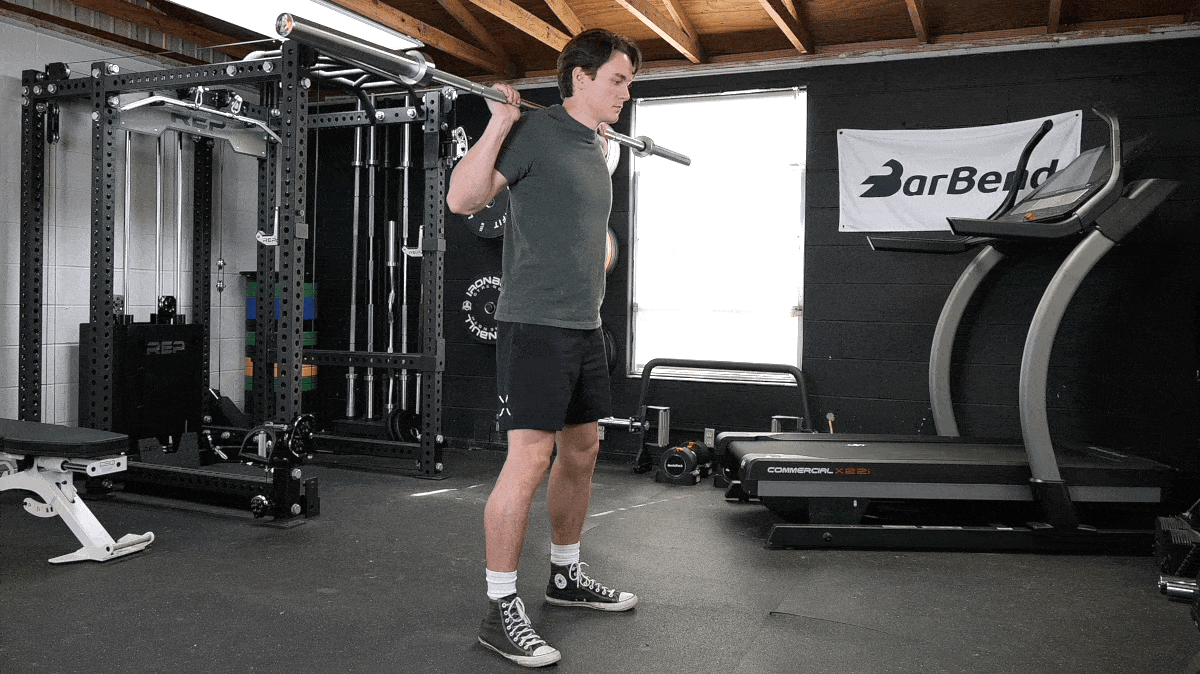
| Equipment Needed | Barbell, weight plates, weightlifting shoes (optional) |
| Muscles Worked | Glutes, quads, hamstrings, lower back |
| Sets & Reps | 3 x 5 |
The ability to breathe in the bottom of a squat position is key to proper posture and bracing, Babenko says. By incorporating a hip hinge as well, you can loosen your posterior chain and warm up your entire lower body at once.
How To Do It
- Unrack an empty barbell and place it on your upper back as you would for a back squat.
- Assume your standard squat stance, then hinge backward into a deep good morning position.
- From the hinged position, sink your butt down and drive your knees forward to fall into the bottom of a deep squat.
- Pause, exhale, then reverse the motion, deliberately shooting your hips up and back until you’re in the hinged position once again.
12. Kettlebell Windmill
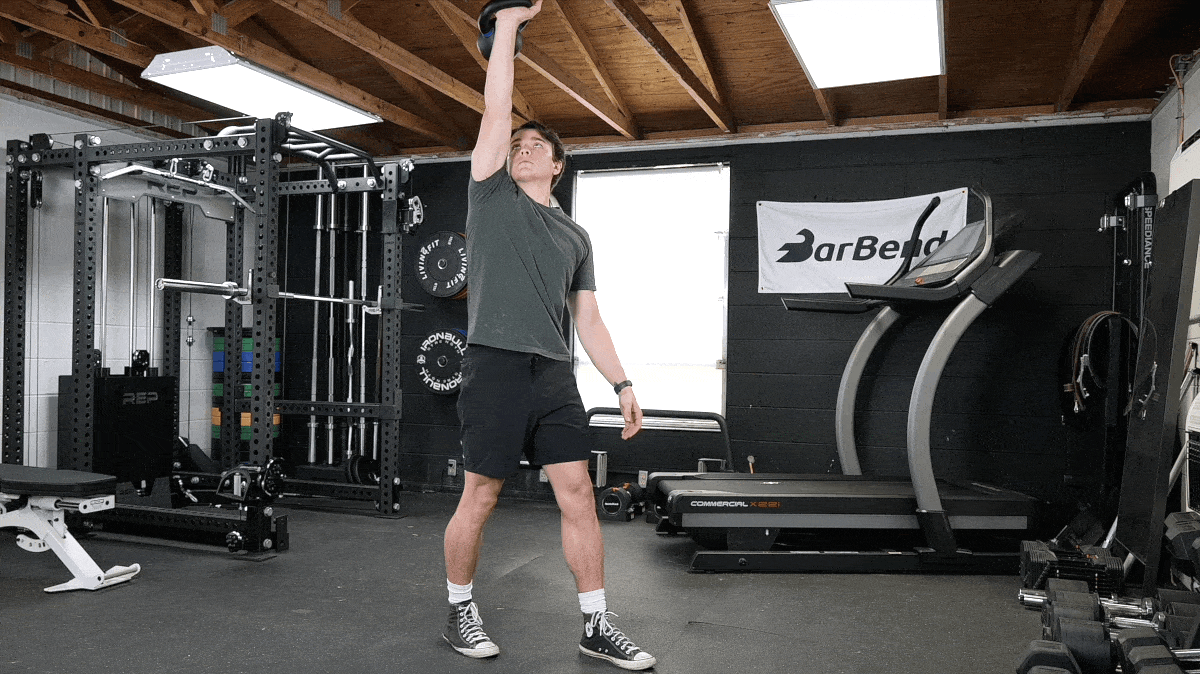
| Equipment Needed | Kettlebell |
| Muscles Worked | Upper back, shoulders, lower back, glutes, hamstrings |
| Sets & Reps | 2 x 3 |
Your shoulder blade sits flush against the back of your ribcage and is the most mobile area in your upper body, which means there’s a large range of motion you need to stabilize. The kettlebell windmill not only stretches your posterior chain, but requires you to isometrically contract your upper back and shoulder girdle to suspend a weight overhead in the process.
How To Do It
- Hold a kettlebell above your head with one arm and take a staggered stance with your legs slightly out of alignment.
- Maintaining a locked elbow in your upper arm, slowly and gradually tilt your torso to one side, reaching down toward the floor with your other arm.
- Lower yourself until you can touch the floor or until you feel a strong stretch throughout your hip and lower back.
3 Mobility Workouts To Try
If you’re struggling with your mobility, even the best exercises in the world only get you halfway there; you need to know how to organize them into mobility workouts of their own.
Mobility Warm-Up
If you associate mobility exercises with your warm-up, you’re not wrong. So how do you warm up… for your warm-up? Research indicates that if you’re warming up with mobility exercises directly prior to your workout, you should focus on deliberate, dynamic movement. Save static stretches for after your session if you can help it. (3)
[Read More: Bodyweight Warm-Up and Cool-Down Mobility Drills]
Here’s how you’d typically ease into your mobility routine at the very start of a session:
- 5-10 minutes light cardio on the treadmill, elliptical, stepper, or skipping rope
- 2-4 joint-specific mobility exercises that involve the muscles you’re using that day
Mobility Workout for Squats
Squats (and all of their variations) are some of the best leg exercises you can do, but proper squat form isn’t always easy to achieve. Mobilizing and warming up for squats at the start of your lower-body workout can make all the difference when you get under the barbell; you need to perform some of the best hip mobility exercises out there, and you can find those right here:
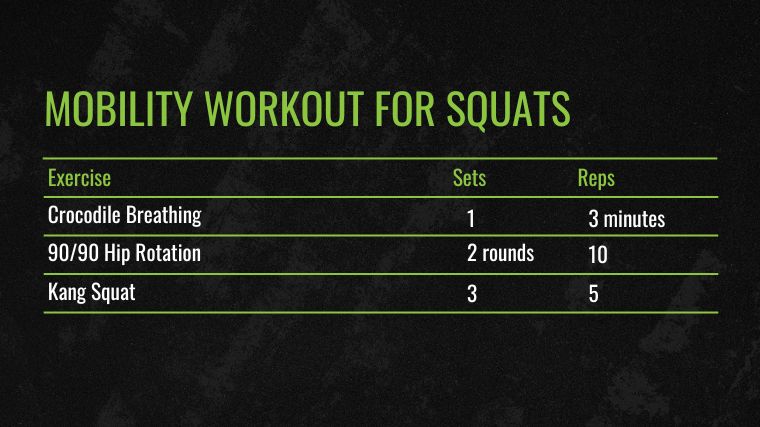
- Crocodile Breathing: 1 x 3 minutes
- 90/90 Hip Rotation: 2 rounds x 10
- Kang Squat: 3 x 5
Mobility Workout for Beginners
Improving your flexibility is essential to hitting the ground running with a new fitness routine. To perform mobility exercises safely, you need the appropriate range of motion. A few different bodyweight exercises aimed at beginners will do the trick:
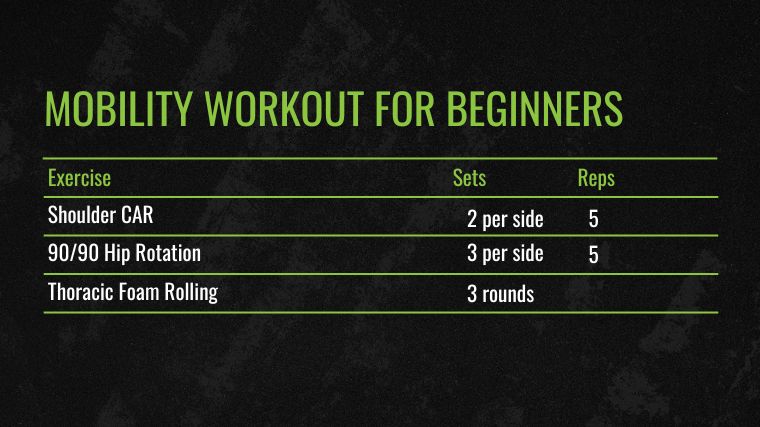
- Shoulder CAR: 2 per side x 5
- 90/90 Hip Rotation: 3 per side x 5
- Thoracic Foam Rolling: 3 rounds
Mobility Workout for CrossFit
CrossFitters need robust mobility throughout most of their joints. Weekly WODs contain many different compound exercises or gymnastics movements that require exceptional mobility. To ensure you’re primed for performance before the clock starts running, hit this sequence, consisting of some of the best shoulder mobility exercises out there:
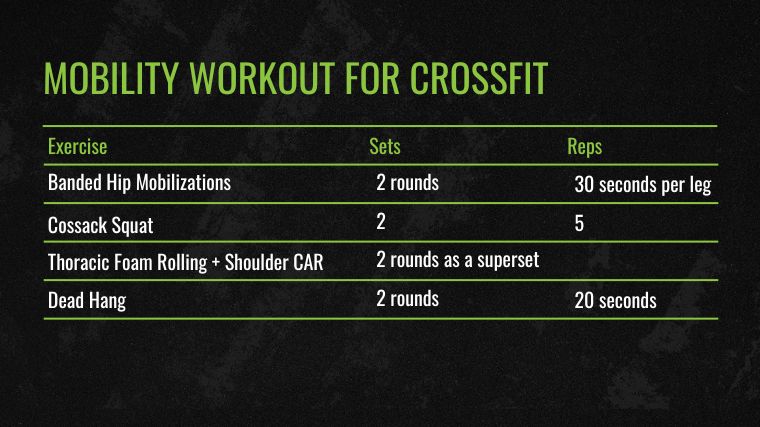
- Banded Hip Mobilizations: 2 rounds x 30 seconds per leg
- Cossack Squat: 2 x 5
- Thoracic Foam Rolling + Shoulder CAR: 2 rounds as a superset
- Dead Hang: 2 rounds x 20 seconds
Benefits of Mobility Exercises
“Mobility benefits can also include pain relief, improved posture, stronger muscles and joints, as well as longevity,” Furr explains. It is important to note that mobility and flexibility are not the same thing; but can work together to create overall improvements to someone’s training regime.”
Now that you’ve got the lay of the land (of your own body), let’s go over some of the benefits of mobility training:
Become a Better Athlete
The ability to change direction quickly without sacrificing speed and quickness is important for a lot of sports and daily life activities. When your muscles are less stiff, your movements are easier and smoother. This translates into better movement mechanics on and off the platform. And the more efficiently you can move, the more effective your workouts will become.
Injury Prevention
Whether you’re running, lifting, jumping, or changing directions in daily life, you’re putting a lot of stress on your joints and muscles. When a joint moves through its full ROM, it improves its ability to absorb force. Therefore, a more mobile joint is generally a safer joint.
[Read More: Mobility Drills to Help You Through Lifting Sticking Points]
When your body has mobility restrictions, it will compensate and find a way to get the movement done. This leads to muscles and joints up and down the kinetic chain trying to do the work of your restricted joint. Over time, this can lead to injuries and pain.
Better Strength and Hypertrophy Potential
Good joint mobility, including wrist mobility, ensures that you can move as efficiently as possible during your lifts. You won’t be improperly compensating for small ranges of motion, so you’ll be able to channel the forces you need to lift most effectively.
When you do that, you’ll be able to move heavier loads. This ability leads to more strength and better muscle-building potential.
[Read More: Wrist Mobility Drills to Do at Work and Before Lifting]
For example, if your hip mobility is limiting your squat or deadlift, you’re not strengthening all parts of the movement and leaving gains on the table. Improving mobility through mobility exercises for weightlifting is therefore a great way to get stronger without weights.
Mobility Training Tips
It’s all well and good to know that you need to do mobility training. It’s trickier to actually ensure that you’re doing it effectively. Here’s how to get started with your mobility exercises.
- Exercise Selection: Prioritize exercises that match your current limitations and are connected to whatever lift you’re doing on any given day
- Sets and Reps: Sets and reps vary. Generally, you’ll want to perform enough of a mobility exercise to feel a mild to moderate challenge or stretch, but not so much that you tire yourself out before a workout or irritate an existing injury.
Focus on Breathing
Whatever you do, don’t hold your breath. It’s tempting — especially if you’re panicking in a new range of motion — to stop breathing during mobility workouts. But instead, match your movements with your breath.
Every time you inhale, imagine making your body longer. When you exhale, sink deeper into the position you’re in. This can give you something to focus on, and it will also signal to your body that it’s safe to relax into its current uncomfortable position.
Start Gradually
Even if you’re very experienced with mobility training, avoid going from zero to 60 immediately. Begin each set somewhat tentatively, and gradually — with each breath — sink into a deeper range of motion.
[Read More: Stretches and Warm-ups to Improve Ankle Mobility]
The same holds true for mobility training on a macro level. Start by getting yourself acclimated to two or three movements, performed with smaller rep counts and holds. Only once you feel comfortable should you add more time, reps, and exercises to the mix. Think of it as progressive overload and ramp-up sets for mobility exercises.
Be Consistent
It might be tempting to skimp on your warm-up or your mobility-specific training sessions. If that sounds like you, try integrating mobility exercises into your rest times between strength sets. You won’t have to schedule in extra time — you’ll be taking rests in between sets anyway.
By working mobility into your rest periods, you’ll prime your muscles for the next set and make mobility training a habit. Hopefully, intra-set mobility exercises will get you increasingly comfortable with mobility training generally, such that you can integrate it into broader aspects of your fitness routine.
How To Track Mobility Training Progress
People often mistakenly think of mobility exercises as a type of fitness band-aid — something you apply to heal an issue and then discard. But the reality is that mobility training is training, and you need to progressively overload it the same way to see real results.
If you’re wondering how to track your mobility progress over time, there are a few ways to go about it. Ask yourself these questions:
- Can you access more of your range of motion without the assistance of a partner or from a weight?
- Are movements or actions that were once restricted or uncomfortable now tolerable or easy?
- Do you experience less discomfort in positions that were once challenging to maintain?
You can, in some cases, also measure your mobility progress more literally. Common mobility screens like shoulder dislocations with a PVC pipe or the knee-to-wall test for ankle dorsiflexion may apply. However, the best way to measure your mobility over time is to work through a progressive plan under the guidance of a qualified clinician.
Frequently Asked Questions
What are mobility exercises?
Almost any exercise can be a mobility movement. However, “mobility exercises” are moves performed specifically to increase range of motion in a specific joint or help you establish better control over that range of motion without relying on external support or other muscle groups.
How can I improve my daily mobility?
The best way to improve daily mobility is to move every day. As they say, motion is lotion. This can be as simple as walking every day for your lower body or as robust as following a daily mobility plan from a physical therapist.
Can I do mobility exercises everyday?
It depends on the difficulty of the exercise, but generally yes, unless your doctor or clinician prescribes otherwise. As a rule of thumb, low-level mobility moves that don’t challenge your balance or involve external weight can be performed on a daily basis if you choose to.
Should you do mobility work before or after a workout?
Both! Pre-workout mobility training is to get you to your “baseline” and ensure that you can train in your range of motion safely. After your workout, perform more vigorous mobility exercises or stretching to further increase range of motion.
References
- Gabbett TJThe training—injury prevention paradox: should athletes be training smarter and harder?British Journal of Sports Medicine 2016;50:273-280.
- Peacock M, Douglas S, Nair P. Neural mobilization in low back and radicular pain: a systematic review. J Man Manip Ther. 2023 Feb;31(1):4-12. doi: 10.1080/10669817.2022.2065599. Epub 2022 May 18. PMID: 35583521; PMCID: PMC9848316.
- Page P. Current concepts in muscle stretching for exercise and rehabilitation. Int J Sports Phys Ther. 2012 Feb;7(1):109-19. PMID: 22319684; PMCID: PMC3273886.
Featured Image: baranq/Shutterstock